Europe, British Isles, England, Channel Islands, Guernsey [Map]
Guernsey is in Channel Islands [Map].
In 1398 John Cobham 3rd Baron Cobham (age 77) exiled at Guernsey [Map].
Chronicle of Gregory 1459. 12 Oct 1459. The Erle of Saulysbury (age 59), the Erle of Warwycke (age 30), the Erle of Marche (age 17), Syr John Wenlocke (age 59), alle thes come unto Devynschyre to Syr John Denham (age 26), and alle thes by the conveynge of Syr John Denham (age 26); and they bought a smalle vesselle in that contray, an they were conveyde unto Garnesey [Map], ande from Garnesaye unto Calys [Map], for fere of dethe that they sayde was ymagenyde by the kyng and hys lordys, and of hyr owne housolde mayny for hyr dystruccyon, the counselle and consent of King Harry the VI. Thes lordys departyd owte of Ingelonde on Synt Edwarde ys evyn, Synt Edwarde bothe kynge and confessoure, the xij day of Octobera, and they taryd at Calys xxxvj wekys.

Note a. This is really the date of the breaking up of their camp at Ludlow, not of their leaving England.
Letters and Papers 1528. 30 Jun 1528. 4440. So they do need patience; but I would sooner endure that than what is inflicted on me, for it does not last so long. But, with your aid, or even without it, I mean to be off. After my protests for the last four months, no one will be able to blame me. Let those who have the charge look to it. Moreover, in choosing the persons, you had better not send an Italian, for Wolsey (age 55) will not have one. Some days ago he told me he would not trust them for their partiality; besides, a man who speaks Latin is required, and he has often been in terrible difficulty for want of it; but you have plenty of bishops and others who will do. In any case, don't send a man who will not spend money, else matters will not mend. I do not speak without reason.
As Wolsey told me he would cause the money of the contribution to be paid to me for you, I spoke to a merchant that it might be paid you at Lyons. Let me know how much is due to you at the end of July, if, as I suppose, it begins on the first day of this month.
Wolsey is informed of great overtures made by the Emperor to the Venetians and duke of Bari, which he thinks they will accept, and that the Duke's ambassador had yielded to the Emperor the investiture of Milan, pretending he had been forced to do so.
The King and Wolsey wish a confirmation by France of the privileges of the isles of Guernsey [Map],-a sort of neutrality which they obtained long ago from the Pope. Such a confirmation was made by Louis XI. London, 30 June.
Around Aug 1561 Leonard Chamberlain (age 57) died at Guernsey [Map].
Henry Machyn's Diary. 30 Oct 1561. The xxx day of October was mad for the berehyng of ser Reynold Chamburlayn knyght and capten of Garnsey [Map] a standard and a pennon and a cote armur and a target, sword, and mantyll, helmet and crest, and a (blank) dosen of skochyons of armes, the wyche he had iiij wyffes and (unfinished)
In 1662 General John Lambert (age 42) was imprisoned in Guernsey [Map]. In 1667 General John Lambert (age 47) was transferred to Drake's Island Plymouth Sound. In Mar 1684 General John Lambert (age 64) died at Drake's Island Plymouth Sound. He was buried in St Andrew's Church, Plymouth [Map].
Pepy's Diary. 30 Jun 1665. Up and to White Hall, to the Duke of Albemarle (age 56), who I find at Secretary Bennet's (age 47), there being now no other great Statesman, I think, but my Chancellor (age 56), in towne. I received several commands from them; among others, to provide some bread and cheese for the garrison at Guernsey [Map], which they promised to see me paid for.
On 03 Jan 1672 Elizabeth Carteret (age 87) died at Guernsey [Map].
Castle Cornet, Guernsey
In Aug 1597 Walter St John drowned at Castle Cornet, Guernsey [Map].
In 1672 Elizabeth Montagu Baroness Hatton (age 59) died at Castle Cornet, Guernsey [Map] after lightning struck a powder magazine.
Europe, British Isles, England, Channel Islands, Guernsey, L'Ancresse
Europe, British Isles, England, Channel Islands, Guernsey, L'Ancresse, Les Vardes Burial Mound [Map]
Les Vardes Burial Mound is also in Prehistoric Channel Islands.
Archaeologia Volume 17 Section XXIX. Guernsey, November 9th, 1811.
My Dear Sir,
A small temporary redoubt was constructed some few years back, on a height near the shore, on the left of Lancresse Bay, three miles from the town in this island. The ground on which this redoubt stood, being composed of a sandy turf, was by degrees levelled by the wind, and the edges of some stones were thereby discovered, which, upon inspection, I immediately knew to belong to a Cromlech or Druidical Temple [Les Vardes Burial Mound [Map]]. I send you a drawing of this Temple, (Plate XVIII.) as it appeared after the sand, which had covered it to the depth of three or four feet, was removed. The two parallel black lines on the back ground, I imagine to have been the sod covered, at different times, with an accumulation of sand blown on it by the wind. I send you also a plan of the surface of the Temple, with the respective measurements of the stones. (Pl. XIX.) They are of a greyish granite, such as form the rocks in that neighbourhood, and are of a rude shape, having the under part flat. The largest of these stones weighs about 20 tons. They are supported by stones of the same kind, of the number and breadth marked in the plan with a dotted line, the highest being about feet above the ground. The temple slopes from west to east; the length of it is 32 feet, and the greatest width between the supporting stones is 12 feet. The soldiers, who were employed in clearing away the sand, have assured me, that there was a stone which closed the entrance into the temple, that some steps led down into it, and that there was a pavement of small pebbles, but I cannot vouch for the truth of these particulars. When I saw the Cromlech, there was certainly no vestige of any steps or pavement. There was, however, a quantity of human and different animal bones found in it, likewise some broken pieces of coarse earthen vessels, together with some limpets, such as are on the rocks in the bay, a few cockle shel's and land snails. These last might have been blown into it by the wind, when it filled with sand, as there are plenty of them on the adjoining common. Some of the fragments of vessels seem to have been blackened with fire, and bear the appearance of antiquity; a vessel of reddish clay was found whole, which held somewhat more than a quart, and was of the shape of a common tea cup. A flat circular bone of some fish, of the shape of a disk, and about nine inches in diameter, was discovered, together with an old fish hook, the former of which was given by the soldiers to Sir John Doyle. I was only able to procure for myself some of the fragments of broken ware. About 18 feet distance from the foot of the temple, there are remains of a circle of stones which probably surrounded it; they are placed about a foot above the ground, and in general about two feet distant from each other. At about 42 feet from the temple, there appears to have been another circle of stones of a larger size than those of the inner circle, but there are very few of them remaining. As this temple stands upon the top of a hill, it is the intention of some gentlemen in the island to have so much of the sand on each side of it removed, as may render it visible to all the surrounding country.
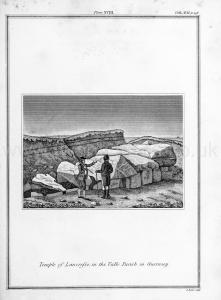
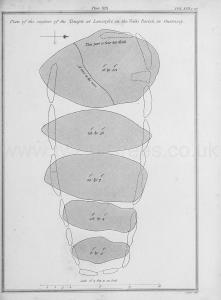
Archaeological Journal Volume 1 Page 142. The first cromlech [Les Vardes Burial Mound [Map]] which was inspected is situate on the summit of a gentle hill, standing in the plain of L'ancresse, in the northern part of Guernsey. The spot was well chosen, being remarkable at a distance, and the highest ground in the neighbourhood. Large blocks of granite are here and there visible on the sides, and in their form emulate the quiet resting-place now described. Five large cap-stones are seen rising above the sandy embankment which surrounds the place: these rest on the props beneath, and the whole catacomb is surrounded by a circle of upright stones of different dimensions. The length of the cromlech is 41 feet from west to east, and about 17 feet from north to south, on the exterior of the stones. At the eastern entrance the remains of a smaller chamber is still seen; it consisted of three or four capstones, and was about 7 feet in length, but evidently within the outer circle of stones. At the period it was constructed the sea was at a greater distance from the site of the hill than at present, for the whole neighbourhood bears marks of the inroads of that element: the near approach of the sandy hills around it was caused by those events which have so materially changed the coast of these islands, as well as that of the opposite continent. The period assigned for this devastation is doubtful, but as early as the fifth or sixth century, the Mont St. Michel, in France, once standing in the midst of a wood, was left "in periculo maris" by the incursions of the surrounding ocean. Before these events however happened, the cromlech now spoken of was in existence, and it stood like a faithful guardian of the trust reposed within its sacred limits. The discovery of this monument, and its partial disturbance, took place in the year 1811, by a party of soldiers, who were permitted to dig about it, but after a few days of unprofitable labour, the fears that the massive cap-stones would fall in, induced the then lieutenant-governor to discontinue the work. The sand being allowed to accumulate, the whole was nearly again covered, when in 1837 I commenced the investigation of this ancient monument of the dead.
Quarterly Journal of Science 1870 I. One curious characteristic of these monuments may be noticed more in Guernsey than in Jersey, viz. that the majority of these structures are within sight of one another. Undoubtedly, in primeval times, such monuments were in existence on every headland round the coast; and it is possible that signal fires may have been used in connection with them. Most of these characteristic features are exhibited in the large cromlech on L'Ancresse Common [L'Ancresse [Map]], which stands on an eminence, called by the inhabitants of the Clos du Valle, Mont St. Michel, whilst the structure itself they call L'Autel des Vardes [Map]. Two photoxylographs are given of this interesting structure from different points of view ( see Plate I., Figs. 1 and 2 ); but although the huge capstones are well shown, and the gradual diminishing of their size towards the east, still no outside view can convey any idea of the size of the chamber and passage beneath, in consequence of the sand and soil being so heaped up around the outside of the structure, that only the tops of the side props are visible. However, at the west end one may stand upright beneath the largest capstone; and when the soil was removed from the floor during the exploration of this cromlech by Mr. Lukis and his sons, the height of the western chamber was eight feet. The westernmost upright block is almost identical in size and shape with those blocks occupying similar positions in the cromlechs of the Creux des Fées [Map], Mont Ubé [Map], and the Pocquelaye [Map].
Quarterly Journal of Science 1870 I. On the north side of the L'Ancresse Cromlech [Map], under the largest capstone, an evident disturbance of the pristine condition of the structure has taken place, one of the side blocks having been pushed outwards apparently, and smaller stones added, so as to form a supplementary kist, in which human remains were found, indicating a secondary interment. It would take up too much space to detail the relics found at the excavation of this structure; it is sufficient to mention that they were all attributable to the Stone age, and have been fully described by Mr. Lukis in the Archæologia, and by Messrs. Worsaæ and Thoms.
Llewellynn Jewitt 1870. In the Channel Islands the indefatigable and laudable researches of Mr. Lukis (age 81) show that the galleried stone chambers of the tumuli in that district had been used by successive generations for many ages. One of the most important of these is the gigantic chambered burial place, surrounded by a stone circle, at L'Ancresse [Map], in Guernsey. In this, "five large capstones are seen rising above the sandy embankment which surrounds the place; these rest on the props beneath, and the whole catacomb is surrounded by a circle of upright stones of different dimensions. The length of the cromlech is 41 feet from west to east, and about 17 feet from north to south, on the exterior of the stones. At the eastern entrance the remains of a smaller chamber is still seen; it consisted of three or four capstones, and was about seven feet in length, but evidently within the outer circle of stones"1. In a careful examination made by Mr. Lukis (age 81), many highly interesting features were brought to light, of which he has given an excellent account in the "Archaeological Journal,"2 to which the reader cannot do better than refer. The engravings there given, show the interiors of some of the chambers, with their deposits in situ, and exhibit some of the highly interesting relics found during the excavations. The pottery was of a totally distinct character from that of the Celtic period found in England, some of the forms being of what are usally considered the Anglo-Saxon type, and are the result of the use of these chambers by successive generations, as already named.
Note 1. F. C. Lukis.
Note 2. Vol. I. p. 142.
Europe, British Isles, England, Channel Islands, Guernsey, La Mare es Mauves Burial [Map]
La Mare es Mauves Burial is also in Prehistoric Channel Islands.
Archaeologia Volume 17 Section XXIX. The third [La Mare es Mauves Burial [Map]] is situated between Lancresse Bay and the Valle Church, and is partly concealed by furze (PI. XXII. fig 3.).
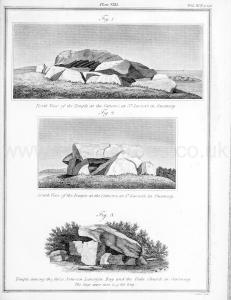
Quarterly Journal of Science 1870 I. From the hill on which the great cromlech of L'Ancresse stands, other megalithic structures can be seen; for instance, in an eastern direction, and near the foot of the hill, are various blocks of stone, the relics of a cromlech, known from its position by a marshy pond as La Mare aux mauves [Map], not far from which again is a portion of a stone circle, and some stone graves of the Bronze period. In the centre of the common is an interesting Kistvaen, consisting of a large oddly-shaped capstone ( probably only a portion of the original stone ), supported on several props. On one of these blocks are some barely-distinguishable cup-markings1; whether natural or artificial is mere conjecture. A Logan or rocking-stone once existed on a natural cropping out of rock to the eastward of L'Ancresse; the site still bears the name of La Rocque Balan.
Note 1. Since writing the above, the author has again examined those cup-markings, which, now that the lichens have been cleared out of them, present evident signs of artificial handiwork. They are nine in number, at the side and top edges of the N.E. prop.-S. P. O., February 4, 1870.
Europe, British Isles, England, Channel Islands, Guernsey, Le Creux ès Fées Burial [Map]
Le Creux ès Fées Burial is also in Prehistoric Channel Islands.
Le Creux ès Fées Burial [Map], aka Cave of the Fairies, is a Neolithic passage grave. It is 9 metres long with a narrow entrance expanding into a round ended chamber. Two of the original capstones survive and it is probable that the whole structure would have been roofed. The remains of an earth mound, which would have originally covered the tomb, measure some 18 meters in diameter. Stones from the surrounding kerb which have been re-positioned are visible on the north side of the mound. Soldiers stationed nearby used to use it as a den so the tomb was filled with rubble to prevent this.
Quarterly Journal of Science 1870 I. The last illustration accurately represents the present condition of a cromlech in the parish of St. Saviour, Guernsey, known by the name of the Creux des Fées [Map], and which well exhibits the peculiar features of the French Grottes des Fées and Allées couverts. The western chamber is still covered in by a great portion of the original superimposed tumulus, and in fact forms a subterranean chamber or grotto, with the narrow passage entrance, now uncovered, but formerly covered with transverse slabs of stone resembling the gang-graben of Scandinavia. Only the two largest capstones remain, covering a chamber 21 feet long by 12 feet broad. This chamber has long been used as a cattle stable, and in consequence is not quite so sweet as might be. Here may be observed with advantage the usual method of filling the interstices between the larger blocks with smaller stones, to keep out the soil of the surrounding tumulus. The narrow entrance shown well in the accompanying photoxylograph ( Fig. 2 ) is only 2 feet 6 inches broad. The two stones where the threshold formerly was are 4 feet 6 inches in height. The western upright slab is 6 feet in height, and of the same breadth. The plans of all these cromlechs should be compared with one another and those in Jersey; they may be found by those who care to inquire further into their original construction in the Journal of the Ethnological Society ' for April, 1870, to which the reader is also recommended to refer for details concerning the other cromlechs in Guernsey; for in an article of this description it is impossible to enter into details of the numerous pre-historic remains yet extant in the bailiwick of Guernsey and its dependencies. The chief and most noted may be briefly enumerated as follows-viz. Le Trépied Cromlech [Map], the Menhirs of La Pierre Longue [Map] and Le Crocq [Map] (La Pierre pointue, La Chaise au Prêtre, and La Rocque Magié have disappeared before the blast of the quarrymen), and the tumuli or Hougues of Hatnée and Fouqué. Putting aside the pre-historic remains in Alderney, Herm, and Sark, which fully deserve a paper to themselves, and which all carry out the generic resemblance to the galleried tombs of Scania, in Gothland, it is best to proceed to describe one or two of the principal Jersey cromlechs, in which the characteristics mentioned are fully exemplified. Three views of these remains, viz. two cromlechs, those of Mont Ubé and the Pocquelaye, with Le Quesnel Menhir, will be found in a recent number of the 'Illustrated London News,' January 15th, 1870.

Europe, British Isles, England, Channel Islands, Guernsey, Le Trepied le Catiopic Burial [Map]
Le Trepied le Catiopic Burial is also in Prehistoric Channel Islands.
Archaeologia Volume 17 Section XXIX. Another of these temples is seen at the Catioroc [Map], at St. Saviors, of which I have also the pleasure to send you two views, (PI. XXII. fig. 1, 2.)

Europe, British Isles, England, Channel Islands, St Peter Port Guernsey
In Apr 1533 Edouard Carteret (age 57) died at St Peter Port Guernsey.
Europe, British Isles, England, Channel Islands, St Peter Port Guernsey, Le Dehus Burial Chamber [Map]
Le Dehus Burial Chamber is also in Prehistoric Channel Islands.
Archaeologia Volume 17 Section XXIX. One of these is situated near Paradis, at the Clos of the Vale, and is called "La Pierre du déhus [Map]." It stands on a rising ground, and slopes towards the east north east. The stones are of a grey granite. The supporting, or upright stones, are 2½ feet above the ground in the inside, and could not be more, as the bottom is rocky; they form a parallelogram in the inside of 12 feet broad. I send you two views of this temple, (Pl. XX.) and likewise a plan of the surface with the admeasurements, (Pl. XXI.)
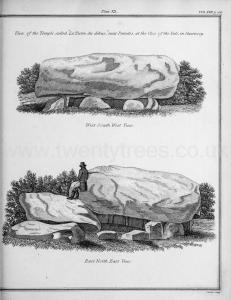
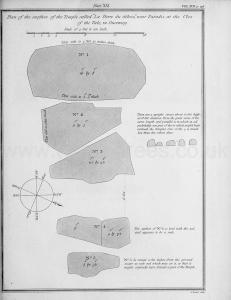
Quarterly Journal of Science 1870 I. Not far to the north-west of Dé-hus [Map] are vestiges of a kist, the capstones of which were destroyed against the wish, and in the absence, of the proprietor; this monument curiously enough bears the name of Le Tombeau du Grand Sarazin, a name in conjunction with a similar appellation given to Dé-hus, significant of the Iberic element, distinctly traceable in the ethnology of the Channel Islanders. A Dolmen, or Trilithon, consisting of a large capstone 13 feet in length, resting on two props, and partly covered by the débris of a neighbouring quarry, still marks the spot where a large cromlech formerly stood in the same parish as the above- mentioned remains; the huge western capstone, now destroyed, bore the name of La Roche qui sonne. An analogous name to this Guernsey Memnon, La Roque où le Coq chante, another site in Guernsey, is mentioned by Victor Hugo in his celebrated work, Les Travailleurs de la Mer, in which he mentions the popular superstition concerning these remains: "Cette pierre est fort à surveiller. On ne sait ce qu'elle fait là. On y entend chanter un coq qu'on ne voit pas, chose extremement désagréable. Ensuite il est avéré qu'elle a été mise dans ce courtil par les sarregousets, qui sont la même chose que les sins. "
Quarterly Journal of Science 1870 I. The cromlech next in importance to that at L'Ancresse, which it rivals in size, is that known by the name of Dé-hus [Map] or Du-Thus ( Deuce ), by some L'Autel du Grand Sarazin ( see Plate II., Fig. 1 ). On examining this structure we see at a glance the large western chamber, with its huge capstone over 16 feet long, and weighing at least 20 tons. The second capstone, that next to the largest, is broken, and the fracture apparently took place during the period of cromlech-builders or their immediate successors, as the larger half of the stone still remaining in situ has been propped up by an additional stone pillar. In all there are eight capstones, which, with the side blocks supporting them, diminish gradually in bulk towards the eastern entrance, which is blocked up by a large stone, analogous to the L'Ancresse and other cromlechs. The narrow orientated gallery is conspicuous likewise, whilst the main body of the structure is divided into three chambers. The most noticeable features however, after all, in this cromlech, are the four side chambers, two to the north and two to the south; these are square and polygonal kists, some of which are entered from the eastern gallery, and others distinct, but all adjoining. In the chamber to the north and east were found two skeletons in a kneeling (crouching?) posture, the flat stone which covers the kist nearly touching their skulls. In the chambers to the south were found several layers of interments, the human bones being disposed in groups crosswise, with the skull on the top, indicating the corpses to have been placed in a sitting posture. There were pavements of flat stones between the layers of interments, which resemble exactly similar instances in the West Gothland tombs1.
Note 1. Nilsson on ' The Stone Age, ' p. 149.
Europe, British Isles, England, Channel Islands, Guernsey, St Saviour